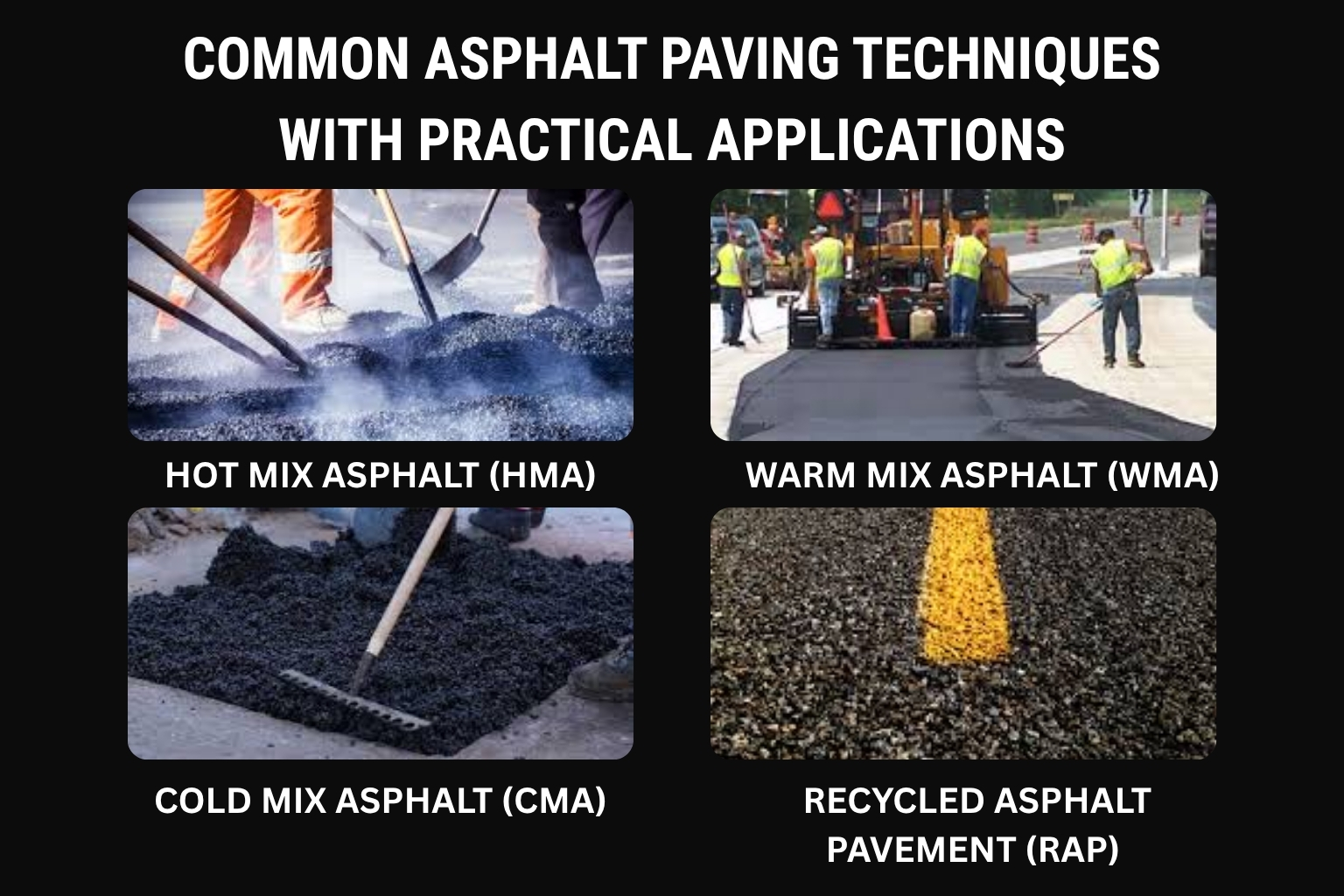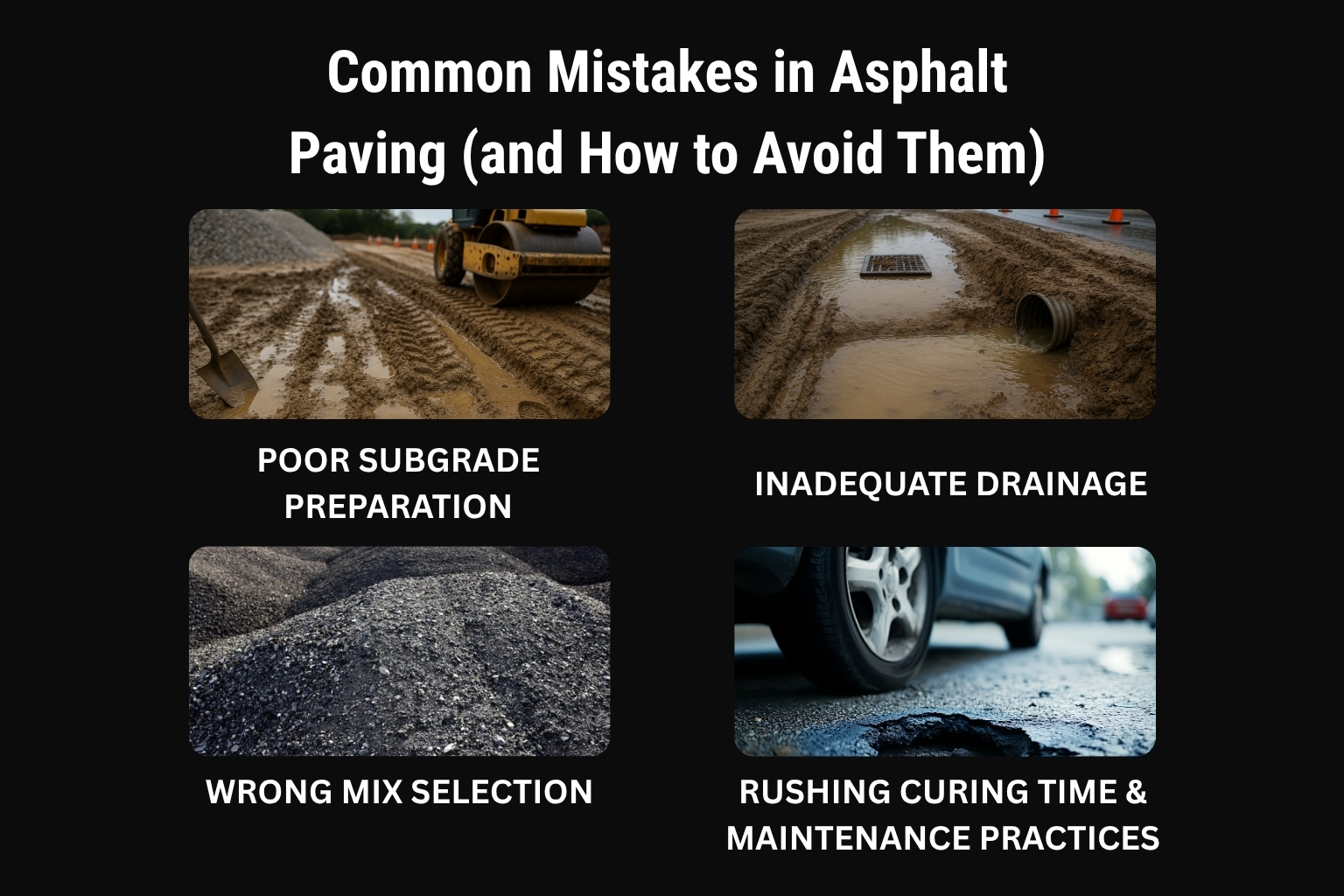As a family‑run asphalt contractor with more than 35 years of experience in North Texas, we know pavement is more than just putting down a new surface. It’s about creating a safe, durable road that suits your budget and the way you use it. In this guide we demystify common asphalt paving techniques, hot mix, warm mix, cold mix and recycled pavement, and explain the factors that make them succeed. You’ll also learn how our local expertise and commitment to quality help you select the best option and avoid common pitfalls.
What is Asphalt Paving? (Definition + Core Concept)
Asphalt pavement is made from aggregates (crushed stone, gravel, sand, or recycled materials) bound together by a bituminous binder. The European Asphalt Pavement Association notes that aggregates provide most of the load‑bearing strength, while bitumen acts as the glue that holds the mixture together. Asphalt mixtures are typically produced in an asphalt plant; hot mix asphalt (HMA) is manufactured at around 150-180° C, and Most mixes contain 90‑95% aggregates and about 4‑8% binder by weight. Once mixed, the hot material is placed and compacted on the road surface, where it cools and hardens to form a durable pavement.
Common Asphalt Paving Techniques (with Practical Applications)

1. Hot Mix Asphalt (HMA)
Hot mix asphalt is the traditional standard for building roads and parking lots. In the HMA process, aggregates and asphalt cement are heated above 300°F and thoroughly mixed. The high temperature makes the binder fluid so it coats the aggregates and remains workable during transport and placement. HMA is ideal for heavy‑traffic highways and airport runways because it provides excellent structural strength and can be optimized for specific climate and loading conditions. However, the high temperatures require more energy, emit more fumes and limit paving to warmer seasons. Quality control, especially temperature management during transport and compaction is critical; if the mix cools too quickly it can be difficult to achieve the density needed for long‑term performance.
2. Warm Mix Asphalt (WMA)
Warm mix asphalt uses additives or foaming processes to lower mixing and placement temperatures by 30-120° F compared with HMA. According to the Federal Highway Administration (FHWA), WMA can reduce fuel consumption during production by about 20% and extend the paving season because the mixture cools more slowly. The lower temperature also improves compaction (helping achieve higher density), allows longer haul distances and reduces fumes and odors at the job site. For property owners, WMA provides a more environmentally friendly pavement without sacrificing performance. When you read more on the FHWA’s Warm Mix Asphalt page, you’ll find that WMA has been used successfully for a variety of pavement types and traffic levels.
3. Cold Mix Asphalt
Cold mix asphalt is produced without heating the aggregates. The European Asphalt Pavement Association explains that this is possible because bitumen is emulsified in water, which breaks during mixing or compaction to coat the aggregate; strength increases as the water evaporates during curing. Because it doesn’t require high temperatures, cold mix is ideal for lightly trafficked roads, pothole repair and remote locations. It’s easy to produce and apply, but it doesn’t achieve the same strength as hot or warm mixes and often serves as a temporary or low‑volume solution.
4. Recycled Asphalt Pavement (RAP)
Reclaimed asphalt pavement (RAP) is material generated when existing pavements are removed during resurfacing or reconstruction. The National Asphalt Pavement Association notes that RAP consists of high‑quality aggregates coated with durable asphalt binder. By milling and reusing this material in new mixes, contractors reduce the demand for virgin aggregates and binders and significantly lower environmental impact. For example, recycling RAP in 2019 saved an estimated 58.9 million cubic yards of landfill space and reduced greenhouse‑gas emissions. The same report states that using about 21 % RAP in new asphalt mixtures saved U.S. pavement owners roughly $7.80 per ton. When designed correctly, RAP mixtures can perform as well as virgin mixes. For more details on RAP recycling, visit the FHWA’s recycling page, which outlines the agency’s sustainability objectives and best practices for incorporating reclaimed materials.
Factors Influencing Asphalt Pavement Quality

Material Composition & Binder Quality
A durable pavement starts with selecting the right aggregate gradation and binder grade. The Wisconsin Highway Research Program notes that durability depends on binder specifications, aggregate specifications, volumetric properties, moisture sensitivity and in‑place compaction. Laboratory studies found that cracking resistance improves when the mix contains more effective binder, uses a softer binder grade, limits recycled binder content, and incorporates polymer modifiers. In practice this means tailoring the binder to local climate and traffic conditions and verifying mix designs through testing. Our team uses high‑quality binders and may recommend polymer‑modified asphalt for heavy or temperature‑extreme applications.
Temperature Control During Laying
Temperature is central to asphalt quality. WMA lowers the mixing temperature and reduces the risk of premature cooling, but HMA still needs to stay above its compaction temperature until the rollers complete their passes. Excessively high temperatures can damage the binder, while too‑low temperatures make the mix too stiff to achieve density. FHWA guidance on compaction stresses that environmental variables layer thickness, temperature, wind speed, solar flux and time available for compaction must be considered when planning the rolling pattern. Our crews monitor ambient conditions and adjust equipment and rolling sequences accordingly to avoid cold spots and ensure a smooth, dense mat.
Compaction Techniques & Equipment
Proper compaction is one of the most important factors controlling pavement life. FHWA research shows that increasing in‑place density by just 1% can boost fatigue performance by 8-44% and improve rutting resistance by 7-66%. Achieving this density requires the right combination of rollers and passes. The same FHWA brief lists common obstacles stiff or tender mixes, weak base, improper rolling patterns and recommends adjusting roller speeds, vibration settings and patterns to overcome them. We use modern vibratory rollers and continuous density measurement tools to meet or exceed density specifications, ensuring long‑lasting pavements.
Curing Time & Maintenance Practices
Asphalt surfaces continue to gain strength after compaction. The Texas Department of Transportation’s full‑depth reclamation guidelines describe three curing phases: initial curing (about 30 minutes-2 hours) allows the surface to gain enough strength to resist traffic; intermediate curing (a few days to two weeks) allows moisture to escape before surfacing; and final curing (30-60 days) brings the material to full strength. Opening a pavement too soon or allowing water to sit on the surface can compromise durability. After the pavement cures, routine maintenance such as sealing cracks, addressing drainage and scheduling periodic overlays will prolong its service life. Our maintenance programs help clients budget for these treatments and avoid costly repairs down the road.
Sustainable Asphalt Paving Methods (Future‑Ready Practices)
Sustainability is at the heart of modern paving. Warm mix asphalt is an environmentally friendly alternative to traditional hot mix; it lowers production temperatures, reduces fuel use and emissions, and improves working conditions. Reclaimed asphalt pavement (RAP) conserves natural resources and saves money 2019 recycling efforts saved $3.3 billion nationwide and diverted millions of tons of material from landfills. Other innovations include recycled tire rubber as an asphalt binder modifier; the FHWA notes that rubberized asphalt recycles waste tires and can deliver long‑life, cost‑competitive pavements. Researchers are also developing bio‑based binders and incorporating waste materials such as plastics and glass into asphalt mixtures to further reduce carbon footprints. Our commitment to sustainability means we evaluate these options and recommend solutions that balance environmental benefits with performance.
How to Choose the Right Asphalt Technique for Your Project
Selecting the best paving method depends on your project’s traffic load, climate, budget and sustainability goals. Heavily trafficked highways or industrial yards usually require hot mix asphalt because of its structural strength and proven performance. For residential streets, parking lots or projects seeking lower carbon footprints, warm mix asphalt offers similar performance with energy savings and reduced emissions. Cold mix asphalt serves well for low‑volume roads, temporary surfaces and pothole patching, while RAP mixtures are excellent for resurfacing when sustainability and cost savings are priorities.
Because there’s no one‑size‑fits‑all solution, we start every project with a thorough assessment of soil conditions, drainage, anticipated loads and budget. Our local knowledge of North Texas soils and weather patterns informs mix design and pavement structure recommendations. Whether you’re planning a commercial parking lot or a rural driveway, our team can help you determine the best technique to meet your needs. If you’re searching for the Best Asphalt Contractor Near Me, our extensive experience and comprehensive services ensure your project is built to last.
Common Mistakes in Asphalt Paving (and How to Avoid Them)

- Poor subgrade preparation – Neglecting to stabilize or compact the base leads to uneven settlement and cracking. We perform site‑specific soil tests and, if necessary, incorporate base stabilization or full‑depth reclamation to create a strong foundation.
- Inadequate drainage – Water is asphalt’s enemy. Improper grading or blocked drains allow water to infiltrate the pavement, causing potholes and rutting. We design proper slopes and drainage structures and recommend sealing cracks promptly.
- Wrong mix selection – Using a mix designed for light traffic on a heavy‑haul road shortens service life. Consult with an experienced contractor to select the correct mix grade and binder for your climate and traffic conditions.
- Insufficient compaction – Failing to achieve target density decreases pavement strength. Following FHWA best practices including monitoring mat temperature and adjusting roller patterns, helps avoid this mistake.
- Rushing curing and maintenance – Opening the pavement to traffic before initial curing or skipping routine maintenance shortens lifespan. Following TxDOT’s recommended curing times and scheduling periodic seal coats or overlays will keep your road in top condition.
By understanding the techniques, materials, and best practices behind asphalt paving, you can make informed decisions and partner with contractors who prioritize quality and sustainability. With decades of local experience and a commitment to long‑term value, we’re ready to help you design, build, and maintain a pavement that stands the test of time.



